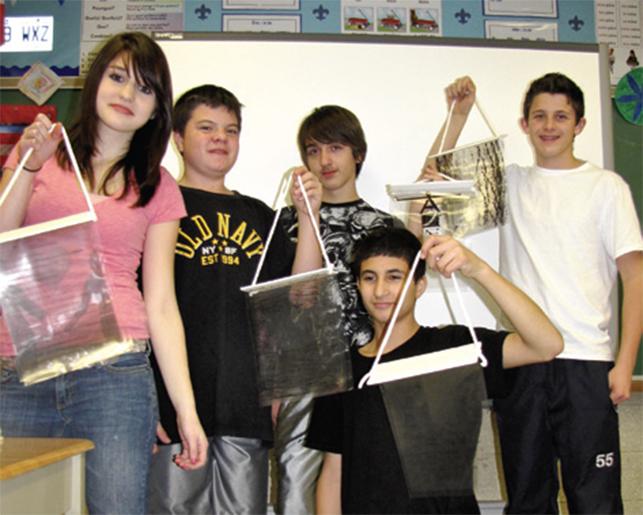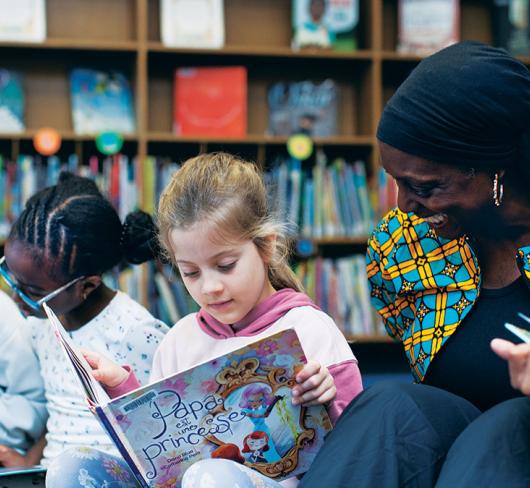
ArtSmart: Using Art to Make Poetry Happen
Two years ago Lisa Galvan and colleague Kevin Alles, members of the Greater Essex County Teacher Local, created a visual arts resource for Intermediate teachers in their board. This was made possible through a grant from the Teacher Learning and Leadership Program (TLLP). The pair developed a series of Web-based lessons that supported generalist teachers with video tutorials, slide shows, extension lessons, and assessment techniques.
Feedback from the TLLP research project led Galvan to create cross-curricular video lessons for all divisions and post these on the ArtSMart website. Galvan and her team (Sherry Doherty, a member of the Greater Essex County Teacher Local; Vicki Papanastassiou, a faculty of education graduate; and Nancy Johns, a Windsor art gallery owner) continue to build the ArtSMart website.
The TLLP has been operating since 2007-08. Teachers funded by the program were featured in “A Big Idea Comes to Life” in the June 2009 issue of Voice (available at etfovoice.ca >backissues>June 2009).
In this article Galvan shows how one teacher effectively used an ArtSMart lesson in a literacy class.
As teachers we accept the challenge of captivating every one of our students. We question engagement, document it, measure it, and we continue to tweak lessons to pique it. As educators, engagement is our test of success. We know that when students are engaged they learn. We see engagement when they are involved in their work, and when they persist in the face of challenges and are visibly happy with their accomplishments.1 However, not every subject, strand, or lesson can meet twenty-first-century demands for engagement and motivational push.
Consider poetry. I have seen first-hand that it can certainly take on a life of its own: lots of students thrive on the metaphoric wonders of the poetic medium. However, I’ve also seen the reverse. What can we do to engage those who struggle with a subject like poetry?
Recently in my role as instructional coach, I had the opportunity to work in a grade 8 classroom at Davis Public School in the Greater Essex County District School Board. The teacher, Nadine Draper, a new long-term occasional teacher, was going to be studying poetry with her students. Together she and I discussed students’ learning styles, needs, interests, and multiple intelligences. As we talked through some of her plans, I wondered how students would react. Full of hope and optimism, Draper felt that the students would be thrilled with the lesson she had prepared.
True enough, several students had a thirst for poetry and were engaged immediately. However, a tension built among those who didn’t share the zeal. As Draper puts it, “Just mentioning the word poetry seemed to send my students into a brick wall.”
“We started brainstorming a typical quatrain poem as a class and they begrudgingly started writing.” Draper recounts. “It was a semi-successful lesson, but mainly because this was more teacher-led than individual. The next step was for students to begin work on their own pieces. I set up poetry centres and asked them write a minimum of five poems, all different genres. The students were very resistant to the idea of writing. They were struggling with creating themes, with brainstorming, and with writing the pieces. I felt defeated.”
Her struggles with these lessons led us to consider what students were feeling and how we might engage them. We asked students to complete a brief survey of their interests; it was clear that we had our work cut out for us. The vast majority – nearly 70 percent – showed limited interest in poetry and few were interested in writing their own.
How were we to engage these students? Daniel Pink, the author of Drive: The Truth About What Motivates Us, links motivation to autonomy, mastery, and purpose. He states that “control leads to compliance; autonomy leads to engagement.”2 Pink explains that autonomy promotes mastery and that purpose provides the context for motivation. We needed to present poetry in a non-controlling way, one that offered autonomy.
Our solution was a culminating task entitled “Layers in Poetry: A Visual Infusion.” This lesson combined poetry and images on layers of transparencies traditionally used for overheads. After poems, words, and images were copied onto the transparencies, the layers were placed in a single foam-core frame centimetres apart, leaving the viewer with a three-dimensional poetic experience.3
Draper says, “Things started to change when I suggested to the class that poetry is not always about rules; rather, it’s about communication.”
The lesson began with an open discussion with students about the possibilities of our learning. Motivation is dependent on context, and we needed to create an intriguing context that would give the students purpose. “Layers in Poetry” showed students they could communicate their own thoughts, feelings, and ideas in a new and powerful way. They plunged into participation as we planned and discussed the excitement of creating three-dimensional works that would have a polished, professional look. We were not going to just draw or paint another picture; rather we were going to be exploring layers and depth of field amid poetic expression and representation. We watched the ArtSMart how-to video for creating our poetic pieces.
Having previewed the short, 12-minute video, the teacher was able to do a think-aloud, pausing at preplanned moments in the lesson.
The students learned how to create a layered piece, questioned and wondered, then wrote in their journals and planned. Some began writing while others searched the Internet for images and creative inspiration.
Things started to come together quickly over the next few days. Students brought in old photos, computer-generated images, and phrases they were shaping into poetry. Small-group sessions ran fluidly throughout the periods of editing and rewriting. Some students began to assemble their work, while others altered or zoomed in on their images, using the photocopier.
Draper says, “I am not necessarily an artistic person. Visual arts is a difficult subject for me, but using this video showed me that I can help my students create interesting works of literature and art. ArtSMart has been invaluable in the drive to motivation and engagement.”
As students were completing their works, we distributed another survey. There was abundant data supporting learning. One student said, “The pictures that I used brought back a ton of memories.” She was writing a poem about her grandfather and initially struggled with the right words. The images helped her to return to a place where she could pull words from her emotions.
We heard comments like “It was easier doing it this way”; “more interesting”; “less of something I have to do and more something I choose to do”; “helps with ideas”; and “I was able to understand it this way, it came out a lot easier.”
One boy said, “I am happy because I don’t usually get work done, and I got everything done. If there were more projects like this I would definitely be able to complete my work.” This sentiment was heard from several boys in the class who enjoyed the artistic freedom the project offered.
Poetry, like visual art, can be anything you need it to be; it is expressive communication. In this case, allowing students to learn about the kind of poems that interested them offered autonomy. Students were motivated because the project was based on their own interests; those interests, in turn, developed as they began to understand the purpose and value of communication through art. Mastery developed. Art can spur both motivation and engagement.
Check out ArtSMart for more cross-curricular lessons you may want to use with your students, gecdsb.on.ca/staff/teachers/ArtSMart/
Notes
1. P. Schlechty, “Increasing Student Engagement,” Missouri Leadership Academy, 1994, p. 5.
2. D. Pink, Drive, p.110.
3. ArtSMart, gecdsb.on.ca/staff/teachers/ArtSMart/.

